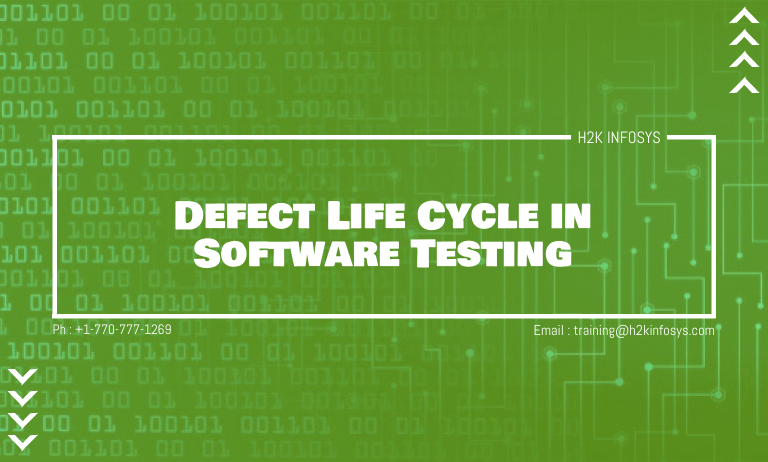For a software product to be developed, the Software Development Life Cycles (SDLC) processes must be followed. But these processes don’t always run smoothly, as different types of defects or bugs are found during software development. As a software developer, you need to identify and resolve these bugs when found, so that a quality software product can be developed.
The main purpose of carrying out software testing is to check if there are hidden elements in software that can damage the product, eventually denting the image of the development team in the long run. That is why software testing is a major part of software development. In this article, we will be looking at everything that needs to be known about the defect life cycle in software testing. So, let’s ride together.
What is a Software Defect?
Before we can fully understand the concept of the defect life cycle, we need to know what a software defect means. A defect, also known as a Bug, can be defined in simple terms as an error that arises in an application, that tends to restrict the normal process of the software or application. A defect does this by mixing up the expected behavior of the software with the way the software should behave.
Mistakes can be made (whether voluntarily or involuntarily) when building or designing software, and when these mistakes are found by a software tester, it is called a defect. A software tester’s job is to locate as many defects as possible because the lower the defects, the higher the quality of software produced. Also, a software testing team must try to understand the defect life cycle, so that they will have an idea of what they are doing when working on the various stages of the life cycle, and starting the defect workflow.
Now that we understand what a software defect means and we know the effects that it can cause on software. Let’s now talk more about the Defect or Bug life cycle.
What is the Defect Life cycle?
The defect life cycle explains the journey that a defect goes through during its existence. It is also regarded as Bug life cycle. The defects go through different stages, and also have different states throughout the entirety of their existence. Every bug that occurs in a software development process has a life cycle. The life cycle starts to form when the defect is first discovered and ends when the software testing team affirms that the defect has been resolved never to reproduce again.
The life cycle differs from project or project, or from organization to organization depending on the company policy, project timeline, and also the software development model used in the organization. Various tools can be used on the defect life cycles. Examples of these tools include JIRA, QC, and so on.
The main purpose of having the defect life cycle is to easily communicate and coordinate the present status of the defect/bug. This makes the process of fixing the bugs efficient and systematic.
What is Defect Status?
Defect status, also known as Bug status, is the current state of the defect or bug. It is important to know the defect status so that the progress or present state of the defect can be precisely conveyed. With this, it is easy to understand and properly track the real progress of the defect life cycle.
What are the states present in a Defect life cycle?
Depending on the nature of the project, the number of states involved in a defect life cycle differs. The states that can be present in a defect life cycle are:
- New
This is the state when a defect has just been registered and posted for the first time.
- Assigned
This is the state when the lead software tester approves the defect as a genuine one after the tester has posted the defect or bug. The lead tester also assigns the defect to the developing team and a corresponding developer.
- Open
When the developer or development team starts analyzing the defects and starts working on resolving the defects, the state is given as Open.
- Fixed
At this stage, the developer or developing team makes the necessary code changes and finishes the task of fixing the bug. The code changes are also verified to ensure accuracy. The defects are then passed to the testing team.
- Pending retest
This state is after the defect has been fixed by the developer. Here, the developer gives a particular code to the tester or testing team. The purpose of this code is for retesting the initial code. It is called a pending retest because the software testing process is pending from the testers’ end.
- Retest
At this stage, the tester then retests the code to know if all the defects are fixed by the developer or developing team. The tester makes sure the requirements are met as regards fixing the defects.
- Verified
At this stage, the bug is tested again by the tester after it has been fixed by the developer. If no defect is present in the software, the tester or testing team then verifies the fact that the bug is resolved. This is why the term ‘verified’ is used.
- Reopen
This is when there are still defects present in the software even after the developer has fixed the bugs. Here, the tester or testing team changes the status of the defect to ‘Reopen’, meaning the defect will undergo the life cycle process again.
- Closed
This state is after the defect has been resolved, and it has been approved by the tester. This means that the tester or testing team believes that there is no defect in the software, and all the defects are resolved, tested, and approved. Therefore, he terms the state ‘closed’.
- Duplicate
This state is when there are repeated defects, or when there are two defects with a similar concept. Therefore, one of the defects has to be changed to ‘duplicate’. This process is done by the developer or the development team.
- Rejected
In this state, the developer or development team agrees that the defect is not genuine, and then rejects the defect.
- Deferred
In this state, the defects found are expected to be resolved in subsequent releases. Many factors determine when a defect is changed. Some of these factors include insufficient time for the release of the defect, the priority of fixing the defect is low compared to fixing other defects, the defects do not have a major effect on the quality of the software, and so on.
- Not a defect/bug
When a state is termed ‘not a defect/bug’, it means that the defect or the bug does not affect the overall functionality of the software or application. For example, when customers ask for changes in the feel and look of the application. Examples of these changes can be changes in text or color of the application. These are not defects or bugs but just changes in the look of the application as requested by the customer.
What are the processes involved in the Defect life cycle?
Some processes should be followed to complete a defect life cycle. They are:
- The tester or development team located the defect or bug.
- A status is assigned to the defect or bug. The state is called ‘New’.
- The defect is then forwarded to the project manager for analysis.
- The project manager will then decide if the defect is valid or not.
- If the defect or bug is not valid, a state is given to it called ‘Rejected’.
- If the defect is valid, the project manager does not reject the defect, but instead, he/she checks whether the bug is within the scope of the project. if not, the defect is given a new state. This is called a ‘deferred’ state.
- The project manager also checks whether a similar bug was detected earlier. If there was a similar bug, the defect is assigned a state. The state is called ‘duplicate’.
- If there are no similar bugs, then the bug is assigned to the developer or development team who begins the process of resolving the code. The defect/bug can be assigned a new state called ‘in-progress.
- After successfully fixing the code, the bug is assigned a new status called ’fixed’.
- The tester then re-test the code. If the code passes the test, the bug is termed ‘closed’, but if the code fails the test, the bug is re-opened and given back to the developer. This state is called ‘re-opened.
What are the guidelines for implementing the Defect life cycle?
Some guidelines should be adhered to for a successful implementation of the Defect life cycle. They include:
- The teams involved (both the development and testing teams) should have a good understanding of the various states involved in a defect, before the commencement of the process of the defect life cycle.
- Every individual assigned to work on any task should fully understand their responsibilities to guarantee quality results.
- The tool that is used for tracking the defects should be handled with care. This is to maintain consistency among the bugs and in the workflow of the defect life cycle.
- There should be proper documentation of the defect life cycle to avoid any form of confusion in the future.
- Every person that is responsible for effecting the change of status to a defect should know the status properly, and also should provide sufficient details about the status and the reason why the status is used. This is to ensure no know is left out as to why status is given to a defect.
Key information to know about Defects
- Finding a defect at the initial stages of development helps to control the cost of quality. This is because it saves effort, time, and cost.
- Defects or Bugs can take place at any point of the software development life cycle process.
- Static testing plays a major role in minimizing debugging costs and finding bugs.
- Documentation of the bug management life cycle is important. This is to ensure that the team fully understands the states of the bugs.
- If a bug occurs, and the bug is fixed in the same phase, then the quality of the system that is being developed is likely to improve.
- Dynamic testing bugs often lead to the failure of the system.
- The details of the bug should be entered to ensure the reason for the issue is comprehended by the whole team.
Tips to write a good defect report
The ability to write a good defect report is an important skill that a software tester should possess. To find the bug in software is only part of the job, this is because developers should be able to replicate the defects or else it would be difficult to resolve them. Some mandatory fields should be included in the software used to defect tracking. This is to ensure that the software testers provide a complete account of the bugs they encountered.
A good defect report should contain a descriptive title, a concise description, the expected results of the tests, details about the software version and the project, details about the platform, the type and severity of the bug, visual attachment, links and tags, assignee, and most importantly, the steps of what you did to locate the bug.
A Duplicate or Invalid Defect Report
The testing environment can affect the location of defects. There can also be a misunderstanding that occurs in the testing process. These types of defects are called invalid defects and a report written for an invalid defect is an invalid report. The Bug Management committee is responsible for determining the validity of a defect. They also determine the itinerary of the process fixing of the bug. This committee consists of Developers, Test Managers, Project Managers, and other stakeholders. The Test Manager is the head of this committee, but the committee is in charge of managing the bug reports. For a duplicate report, one is closed as a duplicate while the other is kept. The priority of the bug to be resolved has to be determined.
What are the data found in a bug?
The data that should be found in a bug is:
- Type of bug
- Type of testing
- Name of the individual
- Severity and priority
- Work product where the bug occurred
- Steps to reproduce the bud
- Project activity taking place when the bug is introduced
- The phase of the life cycle
- Risk, opportunity, loss, and benefits present depending on whether the bug is resolved or not.
- A detailed description of the bug.
- Dates when the phases of the different bug life cycles occur.
- The method of identification.
- The present state of the report.
- References, and so on.
What are the Merits of following the Bug life cycle?
The advantages of following the defect life cycle are:
- It provides better teamwork, communication, and connectivity.
- It delivers a product of high quality.
- It provides customer satisfaction and quality service.
- There is an improvement in the return of investment (ROI) because the cost of development is reduced.
- Issues are detected earlier and the bug trends are easily understood.
What are the Demerits of Bug life cycle?
The difficulties experienced in the Bug life cycle are:
- There is no control of the test environment.
- There are variations in the defect life cycle.
Conclusions
Both the development team and the testing team are essential in resolving defects. There should be effective and smooth communication between both teams so that all errors can be properly resolved. Bug management tools are important to improve the testing process and manage defects that occur from time to time. This is all that is to be known about the Bug life cycle.





























